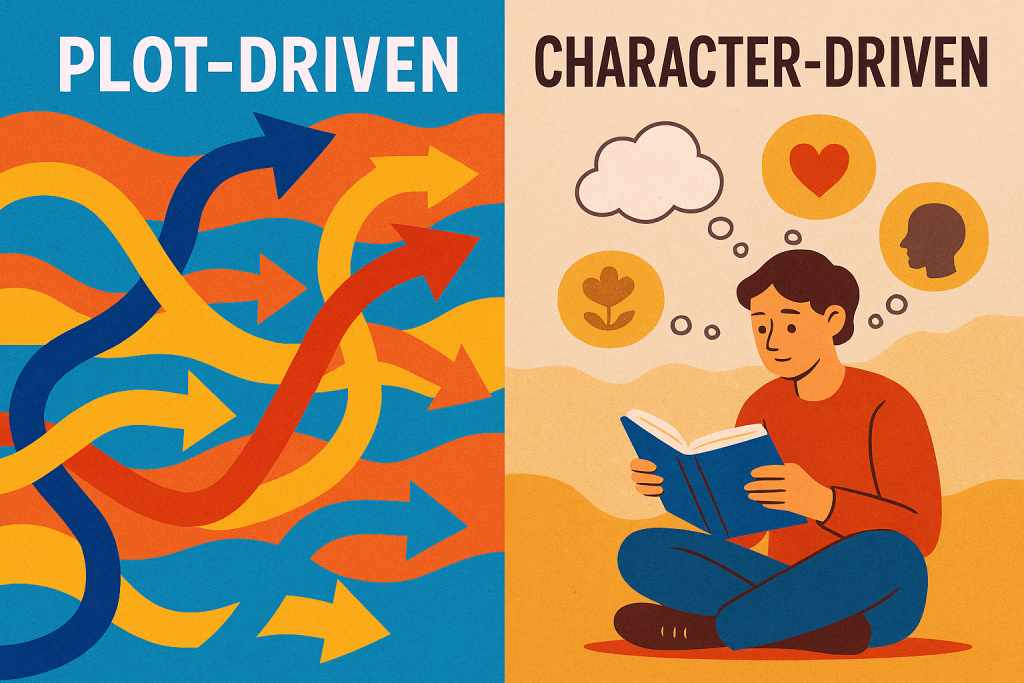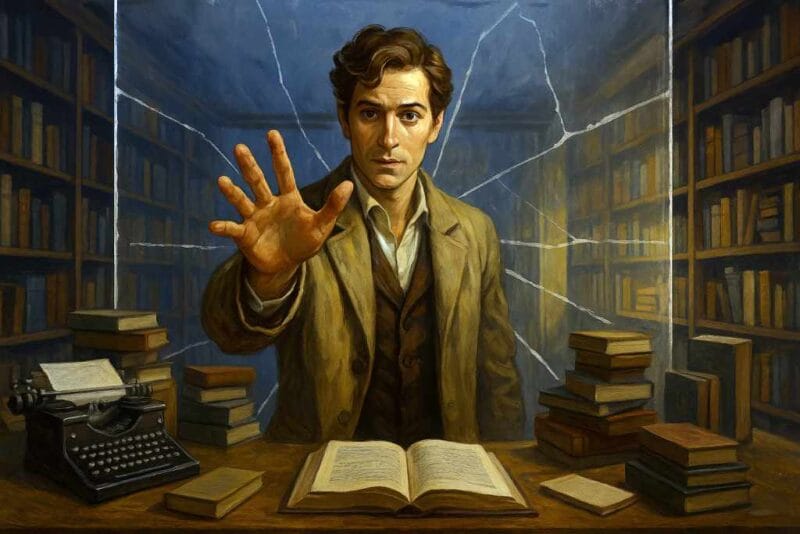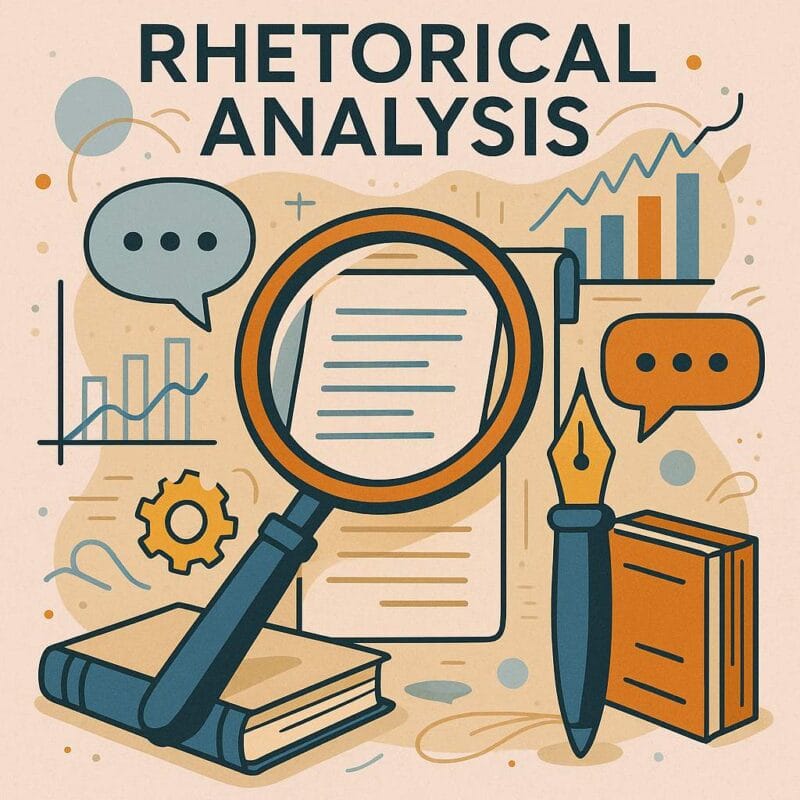In literary fiction, few distinctions are as persistently debated, and often misunderstood, as that between plot-driven and character-driven stories. The binary seems straightforward: one focuses on events, the other on people. But the difference goes far beyond that. These two narrative modes engage time, structure, and causality in fundamentally different ways. Their contrast reflects opposing theories regarding how a narrative’s central thesis emerges.
Writers, readers, and critics alike often default to one mode as a kind of gold standard, depending on their sensibilities. Plot-driven works are praised for their forward momentum and dramatic tension; character-driven ones for psychological richness and narrative patience. But rather than view the two as oppositional, it is more useful to consider how each functions—and what kind of literary work it makes possible.
Narrative Mode Differences
The functional strength of plot-driven fiction is its design, establishing clear expectation and delivering resolution with structural assurance. Defined by external causality, the narrative’s thesis is carried by events and conflict arising from outside pressures. This mode’s visible architecture culminates in closure for the initial tension.
Character-driven fiction, in contrast, prioritizes depth, rewarding the reader with insight into complex internal change that eludes simple explanation. Defined by internal psychology, the thesis is carried by struggle and motivation, with conflict arising from internal dilemmas. The subtle architecture prioritizes psychological exploration that culminates in transformation.
What does it mean to be plot-driven?
This does not mean plot-driven stories lack dimensional characters. What distinguishes these characters is their role within a chain of events. Their personal growth, if it ever occurs, is often catalyzed by what happens to them rather than what emerges from within.
Genre fiction often operates in this mode, but so do many literary classics. Fyodor Dostoevsky’s Crime and Punishment (1866), for instance, is undeniably plot driven: Raskolnikov’s internal torment unfolds through the machinery of murder, investigation, and confession. Similarly, in Margaret Atwood’s The Handmaid’s Tale (1985), the dystopian setting determines both the story’s stakes and the character’s actions.
A well-executed plot-driven novel rewards its readers through suspense, resolution, and a sense of design. The pleasure is architectural: events interlock, tension rises, and nothing is wasted.
What makes a story character-driven?
A character-driven story moves differently. Events still occur, but they are secondary to interior motion. The structure bends around personality, desire, or contradiction. What matters most is not what happens to the characters, but how someone changes—or fails to change. The reader is not pulled forward by action but drawn inward toward temperament, complexity, and perception.
In character-driven fiction, there is often no clear antagonist, no tidy arc, and no imperative to “raise the stakes.” Narrative movement might hinge on small choices, subtle shifts, or slow awakenings. Structure becomes organic, elastic, and at times even elusive. Dialogue, atmosphere, and interior monologue bear much of the weight that action carries in plot-driven works.
Virginia Woolf’s Mrs Dalloway (1925) demonstrates this mode with clarity. A single day in Clarissa Dalloway’s life becomes a site of memory and existential reflection. The plot remains understated—a party, a suicide—but the inner unfolding is immense. Likewise, in Marilynne Robinson’s Gilead (2004), the story is built almost entirely out of thought and introspection. These are novels in which events merely punctuate the larger work of consciousness.
Narrative Structure and Function
The structure of each mode also encourages a different relationship to language. A plot-driven story requires clarity, efficiency, and propulsion. Sentences serve scenes, scenes serve chapters, and each chapter carries the plot forward. A character-driven story, on the other hand, may meander through perception, oscillate between memory and present time, and prize tone over tempo.
Neither is inherently superior. Each of these narrative modes enables a different kind of reading—a different encounter with story, time, and consequence.
When does a story need to be plot-driven?
Some stories demand the grip of plot: a mystery must unravel, a journey must progress, or a system must fail completely. Consequently, primary concerns involve strategic control over the narrative flow: the precise withholding of information, strategic shifts in perspective, and careful management of pace.
Plot-driven stories are especially effective when the premise carries the dramatic tension. In Kazuo Ishiguro’s Never Let Me Go (2005), the slow reveal of the boarding school’s hidden truth functions as a plot device, even as the book maintains a melancholic, character-focused tone. Similarly, in George Orwell’s 1984 (1949), the mechanisms of surveillance and institutional control affect both structure and ideological critique.
The strength of plot-driven fiction lies in its inevitability. When a story is well-plotted, each event tightens the noose. Characters make choices, but within a carefully constructed system. The satisfaction comes from watching a plan—hidden from view—gradually come to light.
When is character the only way through?
Other stories circumvent the convention of plot. Their central thesis arises from what is observed, felt, and remembered, instead of from external events. These works ask the reader to dwell, to reread, and to listen for emotional timbre, rather than tracking the story beats.
In Elena Ferrante’s My Brilliant Friend (2011), the entire story hangs on the tension between two girls growing into women—how they mirror, wound, and define each other. Though much occurs in the Neapolitan neighborhood, the plot recedes behind the emotional and psychological layering of identity and memory. Likewise, in James Baldwin’s Giovanni’s Room (1956), the drama is not found in external events but in the narrator’s conflicted desire, shame, and longing.
These stories get their power from a structural decision. They choose not to rush, they avoid sudden dramatic turns, and they often end without emotional release (catharsis). Instead, they stay true to how most inner lives develop: showing internal holding back, influenced by repeating patterns, and frequently remaining uncertain.
Can a story be both?
Many novels hold tension between the two modes, moving along a plot while immersing into character. The line between them is not always clean. Toni Morrison’s Beloved (1987), for instance, begins with the suspense of haunting and trauma, but as the story moves, the mechanism of plot gives way to character study, poetic memory, and ancestral reckoning.
In Ian McEwan’s Atonement (2001), a mistake made in youth sets off a chain of plot consequences, but the novel’s true concern is interior: guilt, artifice, and the limits of storytelling. In such cases, the narrative blends both modes without diluting either.
This interplay can create hybrid works that reward on multiple levels. The plot engages the reader’s sense of sequence and consequence. The characters absorb them into motive, flaw, and transformation.
Choosing the Mode: What’s at Stake for Writers
For writers, choosing between a plot-driven or character-driven approach is not just about preference. It would determine the structure, voice, and rhythm of their stories. Writers who feel pulled toward movement and design may find themselves energized by the architecture of plot. Those drawn to texture and interiority may need the looseness of character-driven form.
Yet, the most affecting works are often those in which the chosen mode deepens the subject. When the architecture of a thriller becomes a study of paranoia, or when an intimate, introspective novel sharpens into irrevocable change, the form heightens rather than contains the meaning.
Further Reading
Character-Driven Vs. Plot Driven: Which is Best by NY Book Editors
Do You Know What Drives Your Story’s Narrative? by Kristen Kieffer, Well-Storied
On the Many Different Engines That Power a Short Story by Lincoln Michel, Literary Hub
Story driven vs character driven on Reddit




